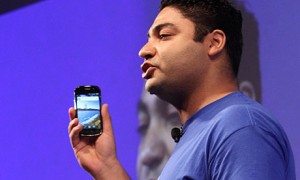 Mobile payments with Google Wallet are growing fast, but the road to wide acceptance of NFC in the U.S. will be slow, the head of Google’s payments unit said Friday.
Mobile payments with Google Wallet are growing fast, but the road to wide acceptance of NFC in the U.S. will be slow, the head of Google’s payments unit said Friday.
The number of NFC (near-field communication) transactions with Google Wallet doubled in the first six weeks after the Aug. 1 launch of a cloud-based version, and that trend has continued, said Osama Bedier, Google’s vice president of wallet and payments, in a session at the Global Mobile Internet Conference in San Jose, California. He didn’t say how many payments that is, however. Google has never quoted an exact number of transactions, and Bedier stuck to that practice.
“We feel like we’re making a huge difference on transaction volume,” Bedier said in an on-stage conversation with Rajeev Chand of investment bank Rutberg & Co.
However, mobile payments won’t be an overnight success, he said. “We didn’t think NFC was just going to happen in a single year. This is a three-to-five-year game,” Bedier said.
U.S. consumers have shown limited interest in mobile payments because the country has a well-developed credit-card ecosystem, analysts say. Payments with NFC require hardware and software in both handsets and point-of-sale terminals. In addition, there are three systems competing, each with a different set of strong backers.
In addition to Google’s NFC payment technology, part of its overarching Google Wallet program for virtual wallets, there are systems being promoted by big mobile operators and by retailers. The ISIS consortium, which includes AT&T, Verizon Wireless and T-Mobile USA, plans to launch its platform in two cities on Monday. In August, a group of stores including Walmart, Target and 7-Eleven formed their own mobile payments network, Merchant Customer Exchange.
“The problem is, there’s a lot of ideas and not a lot of problems being solved,” Bedier said. “There’s room for multiple solutions … but each solution has to have a value proposition.”
Any good mobile payment system needs to help consumers save time and money, make purchases seamless, and work everywhere, Bedier said.
Google enabled NFC in its Android OS in 2010 and was an early adopter of NFC chips in its own handsets, but the company is still looking for support from more mobile operators, according to Bedier. The ball is in their court, he said.
“To make NFC successful, the carriers should come along,” Bedier said. “I think we’ve been very reasonable … but they have to see eye to eye with us on the approach.”
Bedier still expects NFC to catch on in the long term. “I do believe, five years out, you’ll have NFC in almost every phone and almost every terminal,” he said. When that happens, checkout lines will start to disappear as shoppers will be able to complete at least half of their store purchases without going to a checkout counter, he said.





